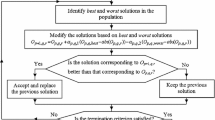Abstract
Due to its ability to generate complex and intricate shape features on different hard-to-cut materials with minimum dimensional deviation and higher surface finish, wire electrical discharge machining (WEDM) process has already become well-acknowledged in various modern-day manufacturing industries. For optimizing the machining performance of this process, applications of numerous metaheuristic algorithms and multi-criteria decision making (MCDM) techniques are already available in the existent literature. In this paper, six recently developed but yet to be popular nature-inspired metaheuristic algorithms, i.e. multi-objective ant lion optimization (MOALO) algorithm, multi-objective dragonfly algorithm (MODA), multi-objective grasshopper optimization algorithm (MOGOA), multi-objective grey wolf optimizer (MOGWO), non-dominated sorting moth flame optimization (NSMFO) algorithm and non-dominated sorting whale optimization algorithm (NSWOA) are employed for Pareto optimization of a WEDM process. From the developed Pareto optimal fronts, the optimal parametric combinations of the said process are extracted with the help of a post priori MCDM tool called combined compromise solution (CoCoSo) method. It is revealed that for all the considered nature-inspired metaheuristics, the optimal parametric intermixes vary with respect to the weights assigned to the responses. However, MOGWO, MOGOA and MODA are able to identify the best solutions 47%, 28% and 20% of the cases respectively.











Similar content being viewed by others
References
Xu, C.S.: Working principle and performance of wire electrical discharge machining. Adv. Mater. Res. 507, 180–183 (2012)
Rao, P.S., Ramji, K., Satyanarayana, B.: Experimental investigation and optimization of wire EDM parameters for surface roughness, MRR and white layer in machining of aluminium alloy. Proc. Mater. Sci. 5, 2197–2206 (2014)
Joshi, A.: Wire cut edm process limitations for tool and die steel. Int. J. Tech. Res. Appl. 2, 65–68 (2014)
Kumar, R., Singh, S.: Current research trends in wire electrical discharge machining: an overview. Int. J. Emerg. Technol. 3, 33–40 (2012)
Sharma, S., Vates, U.K., Bansal, A.: Parametric optimization in wire EDM of D2 tool steel using Taguchi method. Mater. Today Proc. 45, 757–763 (2021)
Shivade, A.S., Shinde, V.D.: Multi-objective optimization in WEDM of D3 tool steel using integrated approach of Taguchi method & grey relational analysis. J. Ind. Eng. Int. 10, 149–162 (2014)
Ay, M., Etyemez, A.: Optimization of the effects of wire EDM parameters on tolerances. Emerg. Mater. Res. 9, 527–531 (2020)
Kavimani, V., Prakash, K.S., Thankachan, T.: Multi-objective optimization in WEDM process of graphene-SiC-magnesium composite through hybrid techniques. Measurement 145, 335–349 (2019)
Das, P.P., Diyaley, S., Chakraborty, S., Ghadai, R.K.: Multi-objective optimization of wire electro discharge machining (WEDM) process parameters using grey-fuzzy approach. Period. Polytech. Mech. Eng. 63(1), 16–25 (2019)
Das, P.P., Tiwary, A.P., Chakraborty, S.: A hybrid MCDM approach for parametric optimization of a micro-EDM process. Int. J. Interact. Des. Manuf. (2022). https://doi.org/10.1007/s12008-022-00869-2
Kalita, K., Pal, S., Haldar, S., Chakraborty, S.: A hybrid TOPSIS-PR-GWO approach for multi-objective process parameter optimization. Process Integr. Optim. Sustain. (2022). https://doi.org/10.1007/s41660-022-00256-0
Zhang, G., Zhang, Z., Ming, W., Guo, J., Huang, Y., Shao, X.: The multi-objective optimization of medium-speed WEDM process parameters for machining SKD11 steel by the hybrid method of RSM and NSGA-II. Int. J. Adv. Manuf. Technol. 70(9), 2097–2109 (2014)
Alduroobi, A.A.A., Ubaid, A.M., Tawfiq, M.A., Elias, R.R.: Wire EDM process optimization for machining AISI 1045 steel by use of Taguchi method, artificial neural network and analysis of variances. Int. J. Syst. Assur. Eng. Manag. 11, 1314–1338 (2020)
Kesarwani, S., Verma, R.K.: A novel hybridization of seagull algorithm and combined compromise solution (SOA-oCoSo) in drilling investigation of carbon nano-onion-modified polymer composites for structural application. Surf. Rev. Lett. (2022). https://doi.org/10.1142/S0218625X22500548
Sharma, N., Gupta, R.D., Khanna, R., Sharma, R.C., Sharma, Y.K.: Machining of Ti-6Al-4V biomedical alloy by WEDM: investigation and optimization of MRR and Rz using grey-harmony search. World J. Eng. (2021). https://doi.org/10.1108/WJE-05-2021-0278
Kalita, K., Ghadai, R.K., Chakraborty, S.: Parametric optimization of CVD process for DLC Thin film coatings: a comparative analysis. Sadhana (2022). https://doi.org/10.1007/s12046-022-01842-1
Kalita, K., Mukhopadhyay, T., Dey, P., Haldar, S.: Genetic programming-assisted multi-scale optimization for multi-objective dynamic performance of laminated composites: the advantage of more elementary-level analyses. Neural Comput. Appl. 32(12), 7969–7993 (2020)
Joshi, M., Ghadai, R.K., Madhu, S., Kalita, K., Gao, X.Z.: Comparison of NSGA-II, MOALO and MODA for multi-objective optimization of micro-machining processes. Materials 14(17), 5109 (2021)
Mirjalili, S., Jangir, P., Saremi, S.: Multi-objective ant lion optimizer: a multi-objective optimization algorithm for solving engineering problems. Appl. Intell. 46, 79–95 (2017)
Mirjalili, S.: Dragonfly algorithm: a new meta-heuristic optimization technique for solving single-objective, discrete, and multi-objective problems. Neural Comput. Appl. 27, 1053–1073 (2016)
Mirjalili, S.Z., Mirjalili, S., Saremi, S., Faris, H., Aljarah, I.: Grasshopper optimization algorithm for multi-objective optimization problems. Appl. Intell. 48(4), 805–820 (2018)
Mirjalili, S., Saremi, S., Mirjalili, S.M., Coelho, L.D.S.: Multi-objective grey wolf optimizer: a novel algorithm for multi-criterion optimization. Expert Syst. Appl. 47, 106–119 (2016)
Jangir, P., Trivedi, I.N.: Non-dominated sorting moth flame optimizer: a novel multi-objective optimization algorithm for solving engineering design problems. Eng. Technol. Open Access J. 2(1), 17–31 (2018)
Jangir, P., Jangir, N.: Non-dominated sorting whale optimization algorithm (NSWOA): a multi-objective optimization algorithm for solving engineering design problems. Global J. Res. Eng. 17(4), 1–29 (2017)
Yazdani, M., Zarate, P., Zavadskas, E.K., Turskis, Z.: A Combined Compromise Solution (CoCoSo) method for multi-criteria decision-making problems. Manag. Decis. 57, 2501–2519 (2019)
Das, P.P., Chakraborty, S.: SWARA-CoCoSo method-based parametric optimization of green dry milling processes. J. Eng. Appl. Sci. 69(1), 1–21 (2022)
Author information
Authors and Affiliations
Corresponding author
Ethics declarations
Conflict of interest
The authors declare no competing interests.
Additional information
Publisher's Note
Springer Nature remains neutral with regard to jurisdictional claims in published maps and institutional affiliations.
Appendix
Rights and permissions
Springer Nature or its licensor holds exclusive rights to this article under a publishing agreement with the author(s) or other rightsholder(s); author self-archiving of the accepted manuscript version of this article is solely governed by the terms of such publishing agreement and applicable law.
About this article
Cite this article
Kalita, K., Ghadai, R.K. & Chakraborty, S. A comparative study on multi-objective pareto optimization of WEDM process using nature-inspired metaheuristic algorithms. Int J Interact Des Manuf 17, 499–516 (2023). https://doi.org/10.1007/s12008-022-01007-8
Received:
Accepted:
Published:
Issue Date:
DOI: https://doi.org/10.1007/s12008-022-01007-8





